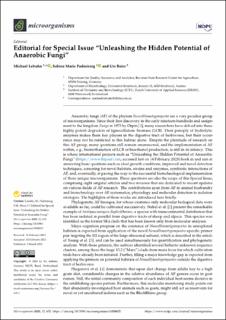Bitte benutzen Sie diese Kennung, um auf die Ressource zu verweisen:
https://doi.org/10.21256/zhaw-29485| Publikationstyp: | Beitrag in wissenschaftlicher Zeitschrift |
| Art der Begutachtung: | Keine Begutachtung |
| Titel: | Editorial for special issue "Unleashing the Hidden Potential of Anaerobic Fungi" |
| Autor/-in: | Lebuhn, Michael Podmirseg, Sabine Marie Baier, Urs |
| et. al: | No |
| DOI: | 10.3390/microorganisms11030652 10.21256/zhaw-29485 |
| Erschienen in: | Microorganisms |
| Band(Heft): | 11 |
| Heft: | 3 |
| Seite(n): | 652 |
| Erscheinungsdatum: | 3-Mär-2023 |
| Verlag / Hrsg. Institution: | MDPI |
| ISSN: | 2076-2607 |
| Sprache: | Englisch |
| Schlagwörter: | Anerobic fungi; Microorganism; Research; Editorial |
| Fachgebiet (DDC): | 579: Mikrobiologie |
| Zusammenfassung: | Anaerobic fungi (AF) of the phylum Neocallimastigomycota are a very peculiar group of microorganisms. Since their first discovery in the early nineteen-hundreds and assignment to the kingdom Fungi in 1975 by Orpin [1], many researchers have delved into these highly potent degraders of lignocellulosic biomass (LCB). Their panoply of hydrolytic enzymes makes them key players in the digestive tract of herbivores, but their occurrence may not be restricted to this habitat alone. Despite the plenitude of research on this AF group, many questions still remain unanswered, and the implementation of AF within, e.g., biomethanation of LCB or bioethanol production, is still in its infancy. This is where international projects such as “Unleashing the Hidden Potential of Anaerobic Fungi” (https://www.hipoaf.com; accessed last on 14 February 2023) hook in and aim at answering basic questions such as ideal growth conditions, improved and novel detection techniques, screening for novel habitats, strains and enzymes, symbiotic interactions of AF, and, eventually, at paving the way to the successful biotechnological implementation of these unique microorganisms. These questions are also the scope of this Special Issue, comprising eight original articles and two reviews that are dedicated to recent updates on various fields of AF research. The contributions span from AF in animal husbandry and biotechnology over AF systematics, physiology and molecular detection to isolation strategies. |
| URI: | https://digitalcollection.zhaw.ch/handle/11475/29485 |
| Volltext Version: | Publizierte Version |
| Lizenz (gemäss Verlagsvertrag): | CC BY 4.0: Namensnennung 4.0 International |
| Departement: | Life Sciences und Facility Management |
| Organisationseinheit: | Institut für Chemie und Biotechnologie (ICBT) |
| Enthalten in den Sammlungen: | Publikationen Life Sciences und Facility Management |
Dateien zu dieser Ressource:
| Datei | Beschreibung | Größe | Format | |
|---|---|---|---|---|
| 2023_Lebhuhn-etal_Editorial-special-issue-anerobic-fungi_MDPI.pdf | 256.18 kB | Adobe PDF |  Öffnen/Anzeigen |
Zur Langanzeige
Lebuhn, M., Podmirseg, S. M., & Baier, U. (2023). Editorial for special issue “Unleashing the Hidden Potential of Anaerobic Fungi”. Microorganisms, 11(3), 652. https://doi.org/10.3390/microorganisms11030652
Lebuhn, M., Podmirseg, S.M. and Baier, U. (2023) ‘Editorial for special issue ‘Unleashing the Hidden Potential of Anaerobic Fungi’’, Microorganisms, 11(3), p. 652. Available at: https://doi.org/10.3390/microorganisms11030652.
M. Lebuhn, S. M. Podmirseg, and U. Baier, “Editorial for special issue “Unleashing the Hidden Potential of Anaerobic Fungi”,” Microorganisms, vol. 11, no. 3, p. 652, Mar. 2023, doi: 10.3390/microorganisms11030652.
LEBUHN, Michael, Sabine Marie PODMIRSEG und Urs BAIER, 2023. Editorial for special issue „Unleashing the Hidden Potential of Anaerobic Fungi“. Microorganisms. 3 März 2023. Bd. 11, Nr. 3, S. 652. DOI 10.3390/microorganisms11030652
Lebuhn, Michael, Sabine Marie Podmirseg, and Urs Baier. 2023. “Editorial for Special Issue “Unleashing the Hidden Potential of Anaerobic Fungi”.” Microorganisms 11 (3): 652. https://doi.org/10.3390/microorganisms11030652.
Lebuhn, Michael, et al. “Editorial for Special Issue “Unleashing the Hidden Potential of Anaerobic Fungi”.” Microorganisms, vol. 11, no. 3, Mar. 2023, p. 652, https://doi.org/10.3390/microorganisms11030652.
Alle Ressourcen in diesem Repository sind urheberrechtlich geschützt, soweit nicht anderweitig angezeigt.